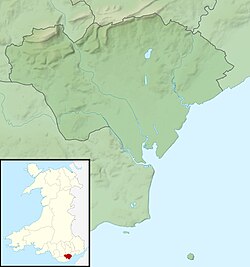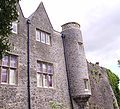History
A medieval castle dating from the 13th century previously existed on the site. By 1536 it lay in ruins. By 1563 the site had been sold to a Dr John Gibbon. A new house was built on the site either by Gibbon or by Nicholas Herbert, who bought the site from Gibbon in 1586. [2] Part of the D-shaped medieval boundary fortifications remain, forming a wall around the current house. [3]
Sir Edward Lewis of The Van, Caerphilly, bought the house in 1616 from the Herbert family in trust under strict condition that it remain in the senior male line of the Lewis family forever. [4] The interior dates partly from then and partly from after 1850, when in the possession of the Windsor-Clive family. [5] Their ownership began in 1833, when the estate was inherited by Lady Harriet Clive (later the 13th Baroness Windsor), wife of the Hon. Robert Clive. Lady Clive undertook much restoration work spanning several decades. [6] The sequence of terraces in the gardens was created in 1865–6 and extended in the early 20th century. [5] The house became a convalescent hospital for soldiers during World War I, with the banqueting hall containing a ward of 40 beds. [7] In 1947, by his will, Ivor Windsor-Clive, 2nd Earl of Plymouth, gave the castle and estate to the National Museum of Wales.
In 1951, Iorwerth Peate, keeper-in-charge for the castle, was allowed by the Hon. John Morgan to select thirty pieces of furniture from Tredegar House for exhibition in the castle’s period rooms; Morgan was disposing of the contents of Tredegar House following its sale in lieu of death-duties. [8]
Buildings in the grounds accommodate the former Welsh Folk Museum, St Fagans National Museum of History. [9]
This page is based on this
Wikipedia article Text is available under the
CC BY-SA 4.0 license; additional terms may apply.
Images, videos and audio are available under their respective licenses.







